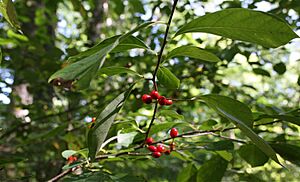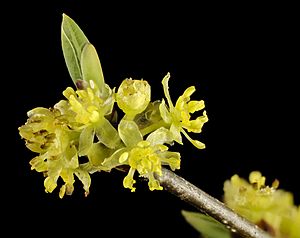Lindera benzoin facts for kids
Quick facts for kids Lindera benzoin |
|
|---|---|
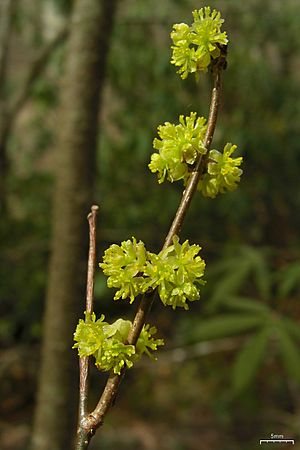 |
|
| Conservation status | |
| Scientific classification | |
| Genus: |
Lindera
|
| Species: |
benzoin
|
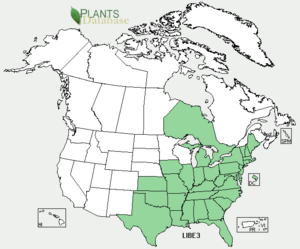 |
|
| Range within North America | |
| Synonyms | |
|
Benzoin aestivale Nees |
|
The Lindera benzoin, often called spicebush, is a cool plant that grows as a shrub. It belongs to the laurel family and is found naturally in eastern North America. You can find it from Maine and New York up to Ontario, and down to Kansas, Texas, and northern Florida.
Spicebush is quite common in its native areas. It likes to grow in moist, rich forests, especially where there's limestone in the ground. It usually grows under taller trees, in the understory.
Contents
What Does Spicebush Look Like?
Spicebush is a deciduous shrub, which means it loses its leaves in the fall. It can grow to be about 6 to 12 feet (1.8 to 3.7 meters) tall. This plant often grows in groups or thickets because it can sprout new plants from its roots.
The leaves grow one after another along the stem. They are simple, meaning they are not divided into smaller leaflets. Each leaf is about 6 to 15 centimeters (2 to 6 inches) long and 2 to 6 centimeters (1 to 2 inches) wide. They are usually oval-shaped with smooth edges. The top of the leaf is dark green, and the bottom is paler.
Aromatic Leaves and Stems
If you crush the leaves or stems, they smell very spicy and citrusy. This is why it's called "spicebush" and "wild allspice." The scientific name benzoin also refers to this spicy smell. In the fall, the leaves turn a bright, beautiful yellow color.
Flowers and Berries
The spicebush has bright yellow flowers that grow in pretty clusters. These flowers appear in early spring, even before the leaves start to grow. They have 6 sepals (leaf-like parts that protect the flower bud) and a very sweet smell.
The ripe fruit is a red, oval-shaped berry-like drupe. It's about 1 centimeter (0.4 inches) long and is full of fats. Many different bird species love to eat these berries. The berries have a taste similar to turpentine and a strong smell. Each berry contains a large seed.
Male and Female Plants
Spicebush plants are either male or female. This is called being "dioecious." If you want to grow spicebush and get berries with seeds, you need to have both a male and a female plant in your garden. In nature, there are often more male plants than female plants. This might be because making berries takes a lot of energy from the female plants.
The stem of the spicebush has bark that feels a bit rough but is flat. It's covered in small, round spots called lenticels, which give it a bumpy texture.
Similar Plants
Other plants in the Lindera family also have "spicebush" in their name and might look similar. For example, Lindera melissifolia grows in swamps in the southern U.S. You can tell it apart because its stems are hairy. Calycanthus, also known as sweetshrub, is in a different plant family but also has aromatic leaves.
Growing Spicebush in Your Garden
Spicebush is often grown in gardens or along the edges of gardens. People like it because of its bright flowers in spring, colorful berries in fall, and its nice round shape. It can grow well in many climates, from USDA zones 4 to 9.
This plant is great because it can grow well in shady spots. However, if you plant it in full sun, it will grow more densely and produce more berries and flowers. It's best to grow spicebush from seeds. Its roots spread out a lot, so it doesn't like to be moved (transplanted) once it's growing.
Special Types of Spicebush
There are a few special types of spicebush that gardeners have developed, though they are not very common:
- 'Rubra' has brick-red male flowers. Its winter buds are also a darker red-brown. Since it's a male plant, it doesn't produce fruit.
- 'Xanthocarpa' has yellow-orange fruits. It was found in 1967 at the Arnold Arboretum.
- 'Green gold' is another male plant that doesn't produce fruit. It has larger, more decorative flowers.
Even though some butterflies and moths use spicebush as a host plant, they usually don't cause serious damage to the plant.
Uses of Spicebush
Because spicebush often grows in rich, fertile woods, early land surveyors used it as a sign that the land was good for farming.
You can make a tea from the leaves, buds, and new twigs of the spicebush. The dried and ground fruits can also be used as a substitute for allspice in cooking.
Native American groups, like the Cherokee, Creek, and Iroquois, used spicebush for various traditional treatments.
Spicebush and Animals
Many animals eat the leaves, twigs, and berries of the spicebush. Some mammals that enjoy it include whitetail deer, Eastern cottontail rabbits, and opossums.
More than 20 types of birds, including gamebirds like ring-necked pheasants, bobwhite, and ruffed grouse, as well as songbirds, are known to feed on spicebush. The berries are a favorite food for wood thrushes.
Host Plant for Butterflies and Moths
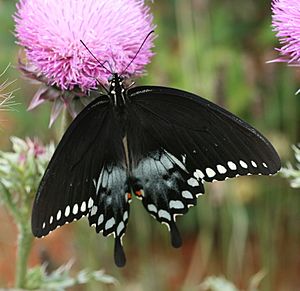
Spicebush is a very important food plant for two types of insects: the spicebush swallowtail butterfly (Papilio troilus) and the promethea silkmoth (Callosamia promethea). It also helps feed the caterpillars of the cynthia moth, eastern tiger swallowtail, imperial moth, and the tulip tree beauty.
You can often find spicebush swallowtail caterpillars inside leaves that they have folded over with silk. When they are small, they are brown and look like bird droppings. As they grow, they turn green. The front part of the caterpillar has two large spots that look like snake eyes, which helps scare away predators.
Since spicebush swallowtails usually have one or more generations (broods) each year, spicebush is a great plant for a butterfly garden. Female butterflies are very attracted to it for laying their eggs. Promethea moth cocoons can be easily seen in winter after the leaves fall. They look like dead leaves still hanging from the twigs. These insects usually don't eat enough to harm a medium to large spicebush, but a very small plant might be affected by even one caterpillar.
See also
 In Spanish: Lindera benzoin para niños
In Spanish: Lindera benzoin para niños



